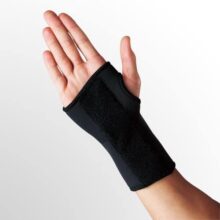Compression Gloves
Login For Health Care Pricing
In Stock
Mueller Sports Medicine Compression Gloves help relieve the pain associated with arthritis and carpal tunnel syndrome.
The wrist is a complex joint that plays a crucial role in the movement and functionality of the hand. A wrist fracture, also known as a broken wrist, is a common injury that can occur due to various causes, such as falls, sports-related accidents, or trauma.
In this article, we will explore the symptoms, diagnosis, and treatment options for a wrist fracture.
When a wrist fracture occurs, it is often accompanied by immediate pain and swelling. Some common symptoms associated with a wrist fracture include:
A fractured wrist typically causes significant pain, which may worsen with movement or pressure on the affected area.
The wrist may appear swollen and bruised due to tissue damage and internal bleeding.
In some cases, a visible deformity or misalignment of the wrist may be present, indicating a severe fracture.
A fractured wrist can restrict the normal movement of the hand and wrist joint.
The affected area may be tender to the touch, and even slight pressure can cause discomfort.
If the fracture causes nerve compression, individuals may experience numbness, tingling, or a loss of sensation in the fingers or hand.
To diagnose a wrist fracture, a healthcare professional will conduct a thorough evaluation, which may include:
In some cases, additional imaging tests, such as magnetic resonance imaging (MRI) or computed tomography (CT) scans, may be ordered to provide a more detailed view of the fracture or assess associated soft tissue injuries.
The treatment of a wrist fracture depends on several factors, including the type and severity of the fracture. Common treatment options include:
For stable fractures, the doctor may recommend immobilizing the wrist with a splint or cast. This helps to keep the bones aligned and promotes healing. The duration of immobilization can vary, but it typically lasts several weeks.
In cases where the fracture is displaced or unstable, a procedure called reduction may be performed. This involves manually realigning the fractured bones before applying a cast or splint.
Severe fractures or fractures that cannot be effectively managed with non-surgical methods may require surgical intervention. During surgery, the bones are realigned and held together using screws, plates, or wires to facilitate proper healing.
Once the initial healing period has passed, a rehabilitation program, including physical therapy, may be recommended. This helps restore strength, flexibility, and range of motion in the wrist joint and hand.
Pain management, elevation, and application of ice packs can also provide relief and aid in the healing process.
It is crucial to follow the prescribed treatment plan and attend regular follow-up appointments to monitor the progress of healing and make any necessary adjustments to the treatment approach.
In conclusion, a wrist fracture can significantly impact an individual’s daily activities and functionality. Prompt diagnosis and appropriate treatment are essential for optimal recovery.
If you suspect a wrist fracture, it is crucial to seek medical attention as soon as possible to receive an accurate diagnosis and begin the appropriate treatment to promote healing and restore normal function to the wrist.


Login For Health Care Pricing
In Stock
Mueller Sports Medicine Compression Gloves help relieve the pain associated with arthritis and carpal tunnel syndrome.

Login For Health Care Pricing
In Stock
LP Support’s Wrist Splint supports weak or overstretched wrists and also treats carpal tunnel courtesy of its removable spoon stay. Its neoprene construction helps keep the wrist joint warm.